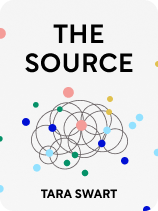

This article is an excerpt from the Shortform book guide to "The Source" by Tara Swart. Shortform has the world's best summaries and analyses of books you should be reading.
Like this article? Sign up for a free trial here.
What’s The Source by Tara Swart about? Do you feel like you’re getting the most out of your brain?
In The Source, Tara Swart says that to achieve your dreams, you must use the full power of your brain. This means understanding how the brain changes itself in response to your experiences, the different modes of thinking, and the major principles of the Law of Attraction.
Read below for a brief overview of The Source.
The Source by Tara Swart
In The Source, Tara Swart explains that to achieve the life you want, you must tap into the full power of your brain and all its different neural pathways. She describes how the brain changes itself in response to our experiences, the different modes of thinking, and the major principles of the Law of Attraction. Though the Law of Attraction is often dismissed as pseudoscience or magical thinking, Swart explains the neuroscientific principles that underlie it and make it work. She then offers a four-step process for how to utilize all this knowledge and brainpower—which Swart collectively refers to as “The Source”—to create the future you want and improve your work life, your relationships, and your own personal development.
Swart is a neuroscientist with a background in psychiatry who advises some of the world’s top business leaders on how to achieve and maintain peak brain performance. She’s also a senior lecturer at MIT and co-author of Neuroscience for Leadership.
Neuroplasticity: How the Brain Changes
According to Swart, understanding how the brain changes itself—a process known as neuroplasticity—is essential to harnessing the full power of your brain, which in turn allows you to achieve what you want most in life and shape your future. Swart explains that the brain consists of 86 billion neurons—or brain cells—which are interconnected, and these connections are responsible for all our brain’s functions, including all our thoughts and behaviors.
Swart says that these neural connections aren’t set in stone: They can change according to our experiences and our responses to those experiences. These changes include forming new neural connections, strengthening and speeding up existing connections, pruning away old neural connections that are no longer needed, and even creating new neurons (neurogenesis).
According to Swart, neuroplastic change is time-consuming and takes a lot of energy. As your brain changes, you’ll find that you often seem to backslide, suddenly struggling again with an aspect of your new skill you thought you had mastered already. When you’re learning, the brain makes short-term changes that don’t immediately translate into long-term changes; the changes only become permanent with repeated practice, so to learn anything new, you must continually commit to learning it.
How to Make Your Brain More Agile
According to Swart, it’s not enough to fuel your brain well; you also have to make a deliberate effort to tap into all its different functions so it can perform at its best and help you achieve the life you want. To get the most out of your brain functioning, you have to improve brain agility: the ability to focus closely on one thing at a time, consider a problem from many different angles, and synthesize ideas from multiple modes of thinking. Swart describes six modes of thinking that together comprise what she calls a whole-brain approach. These are emotional intelligence, motivation, physical attunement, intuition, logic, and creativity.
These modes of thinking are interdependent and influence each other. Swart explains that most people predominantly use two or three of these, and they often consider themselves “bad” at the ones they don’t use as much. But she argues that anyone can hone all six of these modes and develop their brain agility, thus making the best use of their whole brain.
First Mode of Thinking: Emotional Intelligence
According to Swart, the most important mode of thinking to strengthen is emotional intelligence because it’s fundamental to all the other functions of the brain, so it has the strongest effect on the other five modes of thinking. It’s also the mode that people tend to have the hardest time with, because society tends to paint emotions and logic as polar opposites, suggesting that emotions are bad and logic is good.
Because emotions come from the limbic system, which is one of the most primal parts of the brain, we often feel ruled by our emotions. But Swart explains that we can control our emotions and use them to our advantage in maximizing our brain’s potential. Specifically, while we may not be able to determine what emotions we feel at any given moment, we can control our emotional response to anything.
Second Mode of Thinking: Motivation
The second mode of thinking Swart describes is motivation, and it’s closely tied to emotional intelligence. Motivation helps drive us forward when things get difficult, so learning to tap into it will ensure that you’ll have the resilience to keep progressing no matter what challenges you face.
Your motivation often comes directly from your emotions. Swart says that survival emotions are negative motivators, while attachment emotions act as positive motivators. You can use both positive and negative motivators to help you move forward: For example, if your goal is to earn a promotion at work, you might be motivated both by the excitement of taking on a new role (positive motivator) and the fear of not having enough money to get by in your current position (negative motivator).
However, cautions Swart, be careful not to rely too much on negative motivators, which can override your positive motivators and cause you to self-destruct: If your fear of having too little money in your current job becomes your sole motivator, you might become so anxious that your work performance suffers, leading you to be passed over for the promotion. When you begin to feel like negative emotions are weighing you down rather than propelling you, you need to challenge them.
Swart writes that you can challenge your negative motivators by reframing them through a different perspective. Take a step back from the problems that are motivating you and consider them through a wider lens. While your problems are valid and meaningful, remember that everyone in the world faces difficult situations, and there will always be people whose situations are worse than yours. Think about how your problem will feel five years from now: Chances are good it won’t matter anymore. These practices help depersonalize your problems so they have less sway over you and your motivation.
Third Mode of Thinking: Physical Attunement
Another mode of thinking that Swart describes is being attuned to your physical body and senses, which helps you strengthen the connection between your mind and your body. This involves a specific type of sense called interoception, which is the sense related to perceiving the internal workings of your body. Interoception tells you when you’re hungry, tired, too hot, or need to go to the bathroom, among other things. Because emotional responses have a strong impact on the body, being out of touch with your emotions can interfere with your interoception. Thus, when children grow up being told to “get over” what they’re feeling, they often lose touch with their physical bodies and have trouble with interoception.
Sart says that improving your physical awareness and interoception requires you to make a conscious effort to get in touch with how your body feels in response to different situations. She recommends keeping a daily journal in which you record 1) what you eat, 2) how you feel, and 3) how many times you move your bowels. This helps you make the connection between your body’s functions and your mood. She also recommends practicing a body scan, which is a meditative activity in which you focus your attention on each part of your body from the bottom up while breathing deeply.
Fourth Mode of Thinking: Intuition
Next, Swart discusses intuition, which is closely related to physical attunement. We often refer to intuition as “trusting your gut,” and while this may seem metaphorical, research shows that the gastrointestinal and digestive systems actually have a direct impact on our brain’s functioning. Evidence suggests that a healthy microbiome has a positive effect on mood and reduces negative thinking. Additionally, 90% of the serotonin (the “happy” hormone) in our bodies is produced in the gut, further linking gut health with mood.
Swart says that maintaining a healthy gut enables good intuition, which leads to better decision-making. To improve your gut health, she recommends you exercise regularly and maintain a healthy diet like the one we described earlier in the “Fueling the Changing Brain” section. Additionally, she says that managing stress well is essential to a healthy gut—chronic stress reduces the amount of energy the body is able to expend for digestion, leading to digestive problems that negatively impact the brain.
Fifth Mode of Thinking: Logic
According to Swart, logical thinking is what helps us make good decisions. When we engage in logical thinking, we’re attempting to use our pattern recognition skills to identify cause-and-effect relationships in our behaviors and actions and then base our decisions on the effects we expect them to have. This can lead to a sense of accountability for our actions (“If I perform [X] action, I’ll get [Y] result”), which is a good thing, but it can also have the negative side effects of making us fear and avoid risk—and healthy risk-taking is what helps us innovate and make daring choices.
We also often think of logical thinking as being isolated from the other modes of thinking, particularly emotion. But, according to Swart, the opposite is true: Emotion biases every “logical” decision we make, and the other modes of thinking also impact our logical processes. The key to tapping into our logical mode of thinking is to balance it out with the other modes of thinking, on which it’s dependent, and use all our cognitive faculties when we approach complex problems or decisions.
Sixth Mode of Thinking: Creativity
Finally, Swart discusses creative thinking. We tend to think of creative thinking as artistic expression, but this is only one part of it. Creative thinking also encompasses the ability to create a vision for your future and make choices that help you make that future a reality, as well as the ability to come up with new uses and interpretations for existing ideas and improve upon them. This requires you to be confident in your creative abilities, which is where many people struggle, particularly if they’ve been told in the past that they’re not artistic. (Remember, creative doesn’t equal artistic; some people are naturally more artistic than others, but everyone can be creative).
The Principles of the Law of Attraction
Swart explains that once you’ve figured out how to properly fuel your brain and have maximized your brain agility, you can tap into the Law of Attraction to create the future you want. Many people are familiar with the Law of Attraction as a spiritual or faith-based concept, as it’s the focus of a lot of self-help books and programs, but Swart explains that there are actually neurological reasons why this law works. She explains six principles underlying the Law of Attraction. We’ll highlight the two most important of these below.
Principle #1: Abundance
Swart explains that the first step to utilizing the Law of Attraction is to take on an abundance mindset. An abundance mindset is one that perceives the world and the universe as having enough resources to support all who inhabit it, and thinking this way leads you to think positively and behave generously. This is opposed to a “lack” mindset, which is one based in the fear that there’s not enough to go around and that you have to work hard to avoid losing what you have.
Swart notes that the brain focuses twice as much on losses as it does on gains, which means our natural tendency is to go to much greater lengths to steer clear of a loss than we do to achieve a gain. This aversion to risk blocks our ability to change. To take on an abundance mindset, you have to reconsider how you view failure. Failure doesn’t mean you should give up so you don’t lose anything. In fact, failure is vital for success. It’s what propels improvement, and an abundance mindset helps you make improvement an intrinsic motivator.
Principle #2: Manifestation
Manifestation is when your desire and your intentions line up in a way that allows you to attract the things you want in life. Swart emphasizes that this is an action-based concept. It’s not just about thinking happy thoughts and waiting for what you want to magically appear, but rather about focusing on what you want so you can more easily take the actions needed to make it a reality. She writes that manifestation relies on two neurological processes: selective attention and value tagging.
Selective attention is when you focus only on important information while filtering out irrelevant or extraneous information. The brain is constantly receiving massive amounts of information, and it can only focus on a small amount at any given moment. If you devote your limited attention to the things you want in life, you’ll soon find yourself noticing those things more and more because you’re priming your brain to watch out for and alert you to them.
The second neurological process of manifesting is value tagging. This refers to ascribing emotional value to the information you take in. As explained above, emotion heavily influences our thinking and motivates our actions and decisions, so associating a strong, positive emotional value with things that help you progress toward your goal will gear your behavior toward achieving more of those things.
For example, if you enjoyed going on walks with your family as a child, you’ll probably have a positive emotional value assigned to walking or outdoor areas that resembled where you used to walk. If your goal is to spend more time outside or get more exercise, this positive value can help you progress toward that goal. Alternatively, if outdoor walks were a stressful event for you, you may have an aversion to them—so it may be easier to focus on other activities that have more positive associations for you.
The Four-Step Process to Change Your Life
Finally, Swart offers a step-by-step process for utilizing all the above ideas to put your whole brain into action to create the future you want. This is where you’ll apply everything you’ve learned so far.
Step 1: Increase Your Self-Awareness
According to Swart, self-awareness is what helps you identify and take advantage of opportunities for change. She describes several journaling exercises that can increase your self-awareness.
First, Swart recommends a journaling exercise to increase your awareness of how your childhood continues to influence you today. She explains that your upbringing, and particularly what you learned from the people you were attached to, strongly influences who you are today. These relationships served as models for you in childhood. They created neural pathways between triggers (like stress, poverty, and nourishment) and responses, giving you a blueprint for how to deal with the situations in your life. To keep these learned responses from controlling your life, you must be aware of them.
Swart recommends listing things like the roles you and other members of your family played when you were growing up, the secrets your family kept and how they impacted you, the beliefs and values your family held, and how your family viewed boundaries and rules. Consider how these things continue to impact you and write down ways in which you notice them in your life today.
Next, Swart recommends an exercise to help you more deeply understand the patterns and beliefs you picked up from childhood (many of which you’ll have noticed during the first exercise). She suggests listing six beliefs that restrict or obstruct your happiness. Then, for each one, describe the evidence you have to support that belief. Next, write down the evidence you have that contradicts that belief. Finally, reflect on whether these beliefs add or detract from your life, and how you might let go of the ones that don’t serve you.
Step 2: Create an Action Board
For the second step, Swart recommends creating an action board, or a visual representation of what you want to achieve. This will prime your brain to create the change you want by reminding you daily of your goals. Using a piece of paper, some poster board, or any other material that gives you a lot of space to work with, paste images from magazines or online sources that embody what you want to achieve in life. Place this board somewhere you’ll see it every day.
Step 3: Become More Mindful
For the third step, Swart recommends that you deliberately focus your attention on your experiences as they happen, a practice commonly known as mindfulness but that Swart refers to as presence. Staying in the moment like this takes you out of your established patterns, which helps you clear old neural pathways that don’t serve you and create new ones that do.
To become more mindful, Swart recommends practicing mindfulness meditation, which is proven by brain scans to change the structure and connectivity of the brain, which in turn improves your ability to process the information your brain is constantly taking in. This could include a body scan like the one described in the “Physical Attunement” section of this guide. Swart also recommends yoga, or simply taking time a few times a day to deeply focus on the sensory stimulation of a given moment or experience (like eating a meal, taking a walk, or listening to music).
Step 4: Practice
The neural changes Swart describes don’t happen easily or quickly. They require you to actively and regularly devote your whole brain to establishing and reinforcing these changes. All of the principles and steps described above will propel you through the final step.
She recommends identifying the barriers lying between you and the life you want. To do this, draw three columns on a piece of paper and write your goals in the first column. In the second, write the behaviors that are interfering with you achieving these goals. Consider the behavioral patterns you see playing out. In the third column, write down the beliefs that are motivating these behaviors. These are what stand in the way of you achieving an abundance mindset, which in turn halts your progress toward your goals.
Swart also recommends creating a list of affirmations. Write down several inspirational quotes (from books or movies, from people you respect, or directly from your own brain), and repeat them to yourself multiple times a day. This will cement them in your brain and help move your goals from your subconscious to your conscious mind.
Additionally, Swart recommends pushing yourself into new experiences. This will help you overcome the fear of failure that can be so debilitating in creating the future you want. New experiences trigger neuroplastic change in your brain and give you a wider understanding of the world around you. These new experiences can be small or large. For example, you could go hiking on a trail you’ve never been on before or listen to a new genre of music.

———End of Preview———
Like what you just read? Read the rest of the world's best book summary and analysis of Tara Swart's "The Source" at Shortform.
Here's what you'll find in our full The Source summary:
- How to get the most out of your brain by tapping into its immense power
- How to use the major principles of the Law of Attraction
- The four-step process to change your life







Thank you for this summary!!!